Garlic is a famous, easy-to-care, and useful vegetable plant in your garden. Besides making your dishes tastier, you can also use them for health purposes. If you wish to grow garlic, you need to be familiar with its basic care tips. That is what I will share today.
Garlic plant requires direct sun, consistent watering, fertile and well-drained soil, and regular fertilizer. It also needs a cold temperature for bulb vernalization and a warm temperature for root and plant growth. Overfertilization and overwatering your garlic plant can lead to wilting.
There are many things to know. If you wish to plant garlic for the first time, this is the right place to learn about planting, growing, and caring for garlic. Read it till the end to know everything in detail.
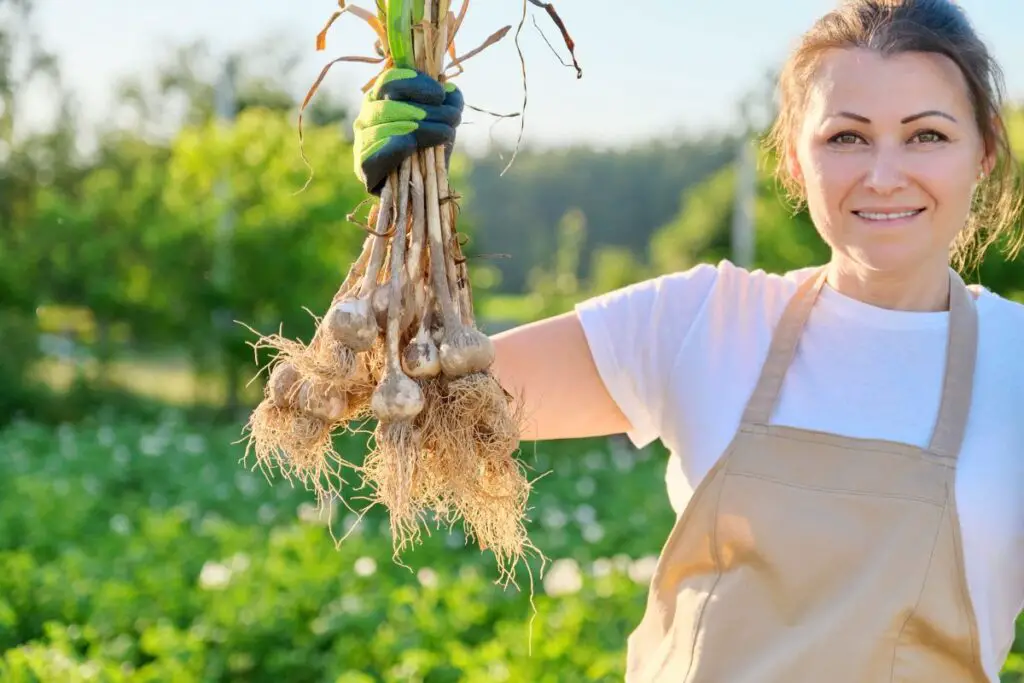
11 care tips for growing garlic
Growing garlic is not so difficult after all.
If you get to know the right care tips, anyone can grow garlic, even a novice.
Here are some tips for growing garlic successfully.
1. Soak the garlic bulbs or seeds before planting.
Caring for garlic starts before planting.
The cloves or seeds sometimes get affected by various bugs and pathogens.
Later, with little carelessness, the bulbs can be attacked by pests and fungi.
To prevent such conditions, you must soak the cloves or seeds before planting.
To prevent diseases, you can soak the garlic into:
- Warm water
- Hydrogen peroxide
- Sterile alcohol
- Baking soda
For growth regulation, you need to soak the garlic in some fertilizers.
However, it also helps in disease prevention:
- Liquid fish
- Compost tea extract
- Diluted kelp
- Organic all-purpose liquid fertilizer
Soaking the bulbs for 15-30 minutes is enough.
For soaking the seeds or cloves in warm water, heat the water at 100-115°F and not more than that.
The heat of the water should be tolerable.
Also read: How Deep And Far Apart Do You Plant Garlic?
2. The best time to plant garlic is in the fall.
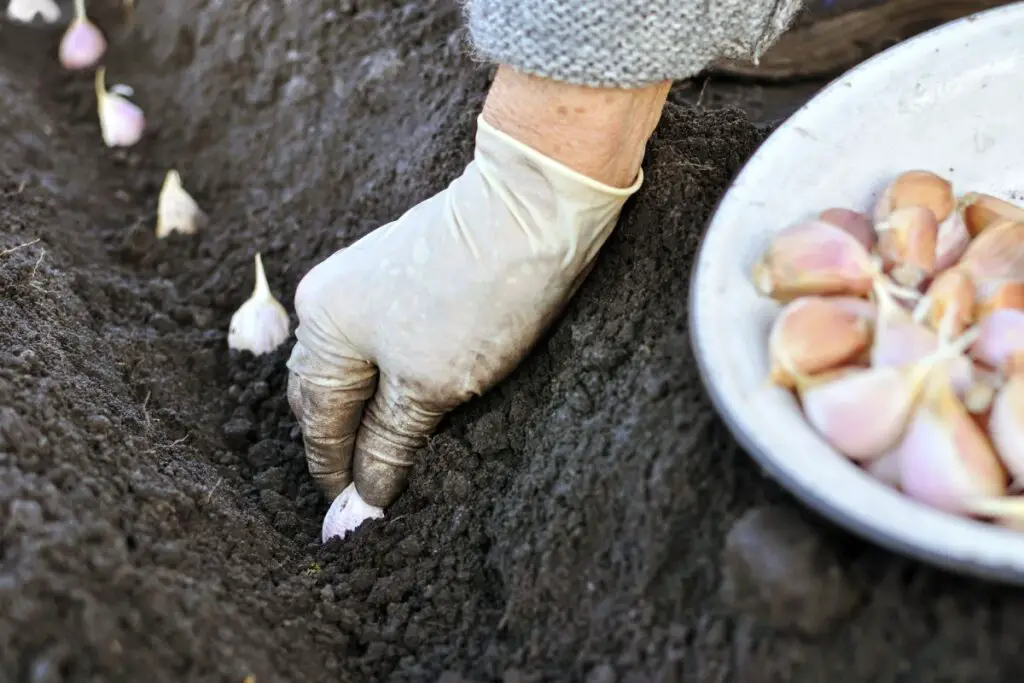
Garlic always responds well when planted in the fall.
When planted in fall, the cloves will get little warmth to develop roots until winter.
When winter arrives, garlic cloves get vernalized when they receive the cold weather and trigger bulb development.
However, you can also plant them in the other seasons, provided the weather conditions are ideal for garlic.
Let’s have a look:
If you have missed fall planting, plant the cloves in the spring.
Before planting, store the cloves in the refrigerator for 6-10 weeks to give them the cold treatment for vernalization.
If you wish to plant garlic in summer, your living region should receive cool summers and warm winters.
If you want to plant garlic in winter, your living area should rarely cross 40-45°F temperature ranges.
Despite so many options, fall is always the best time.
While planting, keep a space of 4-6 inches between the cloves and plant them 2-4 inches deeper.
After planting, add a layer of mulch with straw.
Also read: When To Plant Garlic Bulbs? (+Seasonal Guide)
Looking for gardening supplies? We have tested 100's of products before recommending them to you guys. Check out our best pick below:
| Image | Gardening Supplies | Best Price? |
|---|---|---|
 Top
Top Top
Top | Raised Garden Bed Kit | Check On Amazon |
 | XLUX Soil Moisture Meter, Plant Water Monitor, Soil Hygrometer Sensor for Gardening, Farming, Indoor and Outdoor Plants, No Batteries Required | No Results |
 Top
Top Top
Top | 82 Pcs Garden Tools Set and Extra Succulent Tools Set | Check On Amazon |
 | Joeys Garden Expandable Garden Hose with 8 Function Hose Nozzle, Lightweight Anti-Kink Flexible Garden Hoses, Extra Strength Fabric with Double Latex Core, (50 FT, Black) | No Results |
 Top
Top Top
Top | Dual Chamber Compost Tumbler | Check On Amazon |
 Top
Top Top
Top | Sunnyglade Plant Stakes | Check On Amazon |
 Top
Top Top
Top | Organic Cold Pressed Neem Seed Oil | Check On Amazon |
 Top
Top Top
Top | Mighty Mint Gallon :-Insect and Pest Control Peppermint Oil | Check On Amazon |
 Top
Top Top
Top | Scotts DiseaseEx Lawn Fungicide | Check On Amazon |
 Top
Top Top
Top | Jacks Classic 20-20-20 All Purpose Fertilizer | Check On Amazon |
 Top
Top Top
Top | 30,000 Seeds Pollinator Attracting Wildflower Mixture | Check On Amazon |
 Top
Top Top
Top | Survival Vegetable Seeds Garden Kit-Over 16,000 Seeds | Check On Amazon |
3. Let garlic have sufficient sunlight.
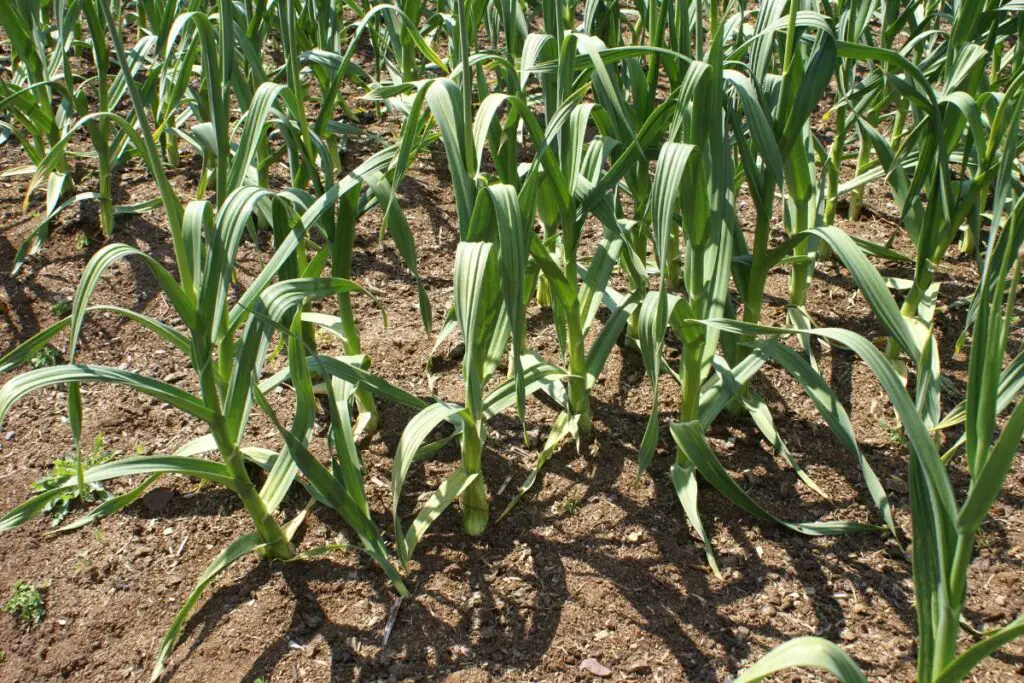
Garlic requires full sun for at least 6-8 hours daily.
It allows the plant to grow well and reach its optimum level at the right time.
A good plant will support good bulb development.
The plant can also stay well if it receives 3-4 hours of sunlight daily.
All the garlic varieties do not require sunlight for 6-8 hours.
Some can stay well with only 4 hours of sun per day.
Garlic will also survive under indirect sunlight, provided they receive 3-4 hours of direct sunlight every day.
Direct sunlight helps in photosynthesis.
Besides, garlic plants will only develop well if they get the sun’s heat.
Without proper sunlight, garlic will stunt its growth, and the bulbs will face several diseases.
The water you provide doesn’t dry out well, thus keeping the soil wet for a long time.
It further invites diseases like pink root, white rot, botrytis rot, rust, and basal rot.
Garlic doesn’t suffer much if exposed to excessive direct sunlight.
Instead, the plant will flourish under direct sunlight.
As long as the plant gets sufficient water, it will continue absorbing the sunlight it needs and gets.
Also read: How Much Sunlight Do Garlic Plants Need?
4. Give the plant sufficient water to remain consistently moist.
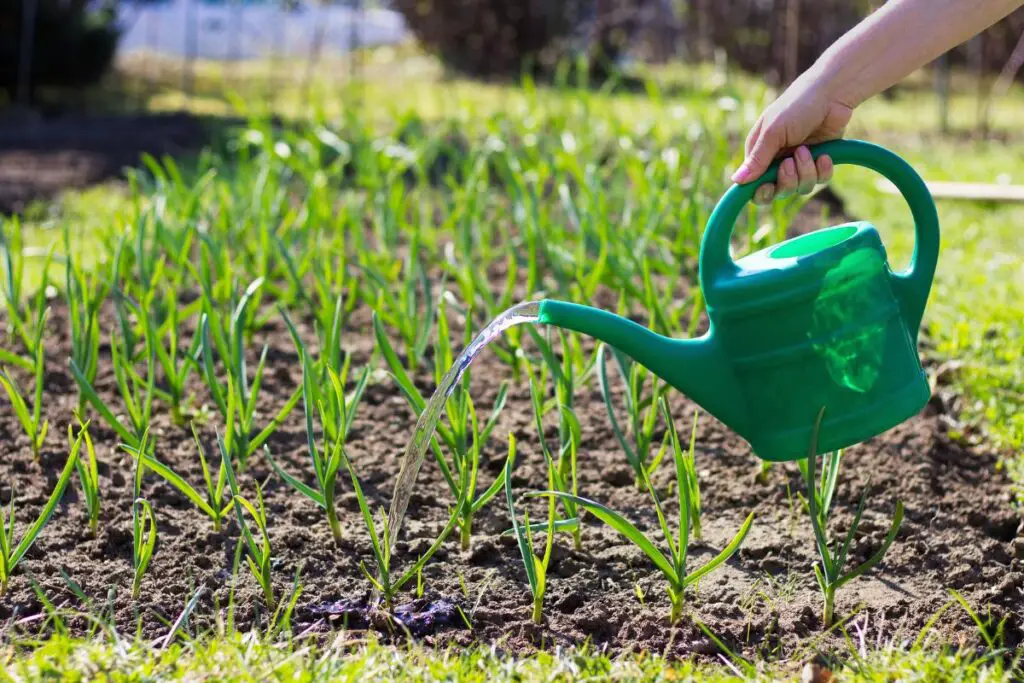
In general, garlic needs watering every 3-5 days in its growing season.
If your region receives rains in spring, you can water them every 7-10 days.
Before watering the plant, let the top 1 inch of the soil dry.
Otherwise, excessive watering can lead to overwatering and then bulb rot.
After planting, water the plant bed thoroughly to moisten the soil properly.
Fall is the season for rain.
You can skip watering for the first period if your region has received enough rain.
Water the plant only when the soil surface has dried.
When the plant is ready for harvest, you should stop watering the plants 2-4 weeks before your planned harvesting date.
In the winters, the garlic cloves stay dormant once the ground freezes.
It will not require any water at that time.
Also read: How Much Water Do Garlic Plants Need? (+How Often)
5. Use the right kind of soil for garlic.
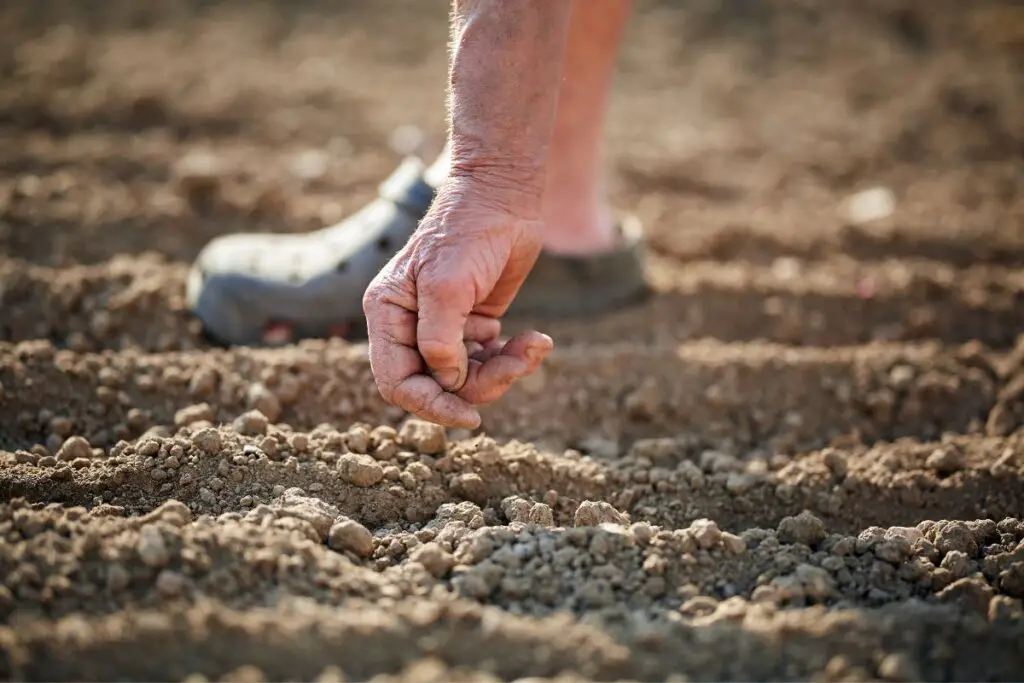
Garlic likes well-drained and nutritious soil for good growth.
Before planting the garlic cloves, find a location with well-drained soil.
Clayey soil can retain water for a long time.
If your garden has clayey soil, use raised beds as they don’t accumulate extra water.
Dig the soil and add some composted manure to improve the soil structure, quality, and drainage.
Also, ensure that the soil has a pH between 6 and 7.
Also read: What Type Of Soil Is Best For Garlic? (Best Soil Mix For Garlic)
6. Don’t forget to fertilize the garlic beds.
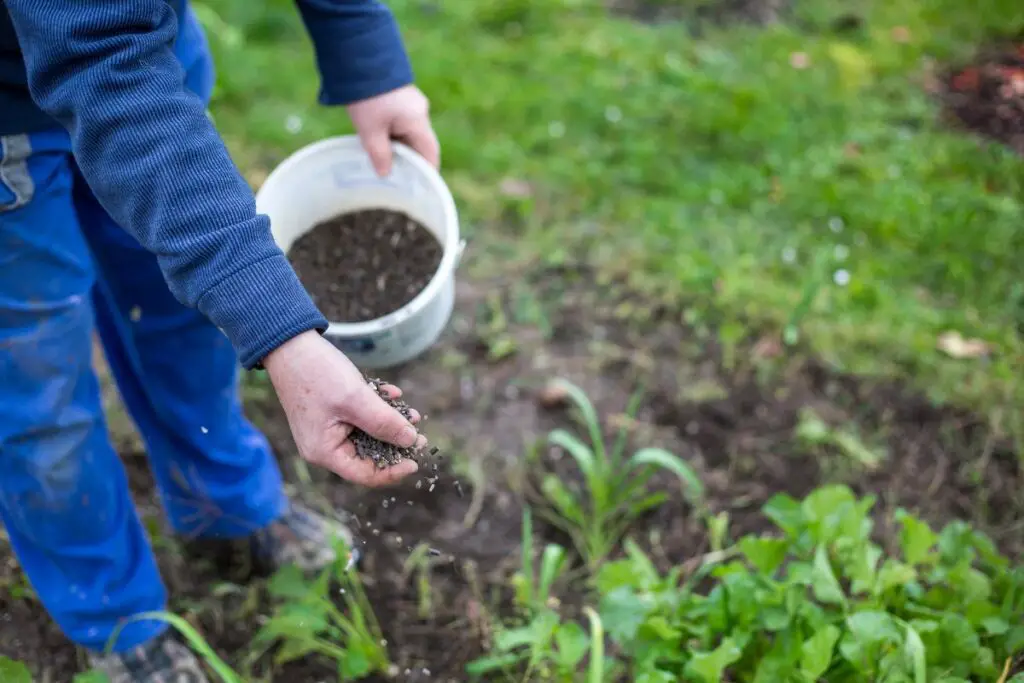
Garlic is a heavy feeder.
Fertilizing them during the growing seasons can boost their growth and make the bulbs bigger, healthier, and tastier.
When you prepare the soil for garlic planting, you can add some fertilizer with compost to make the soil more nutritious.
A nitrogen-rich fertilizer like feather meal should work.
After that, don’t fertilize until spring arrives.
In spring, feed the plant with a balanced fertilizer with NPK 10-10-10 or one rich in Nitrogen.
When the plant has been established, use a fertilizer that goes low in nitrogen and high in potassium.
There are many options for fertilizers.
You can use both organic and inorganic fertilizers.
Organic fertilizers include fish emulsion, bone meal, blood meal, humus, kelp, or seaweed.
You can also use compost manure like cow dung, goat manure, pig manure, or horse dung.
Some household fertilizers are Epsom salt, wood ash, and coffee grounds.
In the winters, the garlic cloves become dormant due to frozen ground.
So, there is no need to fertilize the plant at this time.
Fertilizing in winter will only lead to over-fertilization, further deteriorating bulb growth and development.
Also read: When To Fertilize Garlic? (+Best Fertilizer For Garlic)
7. Garlic can endure a wide range of temperatures.
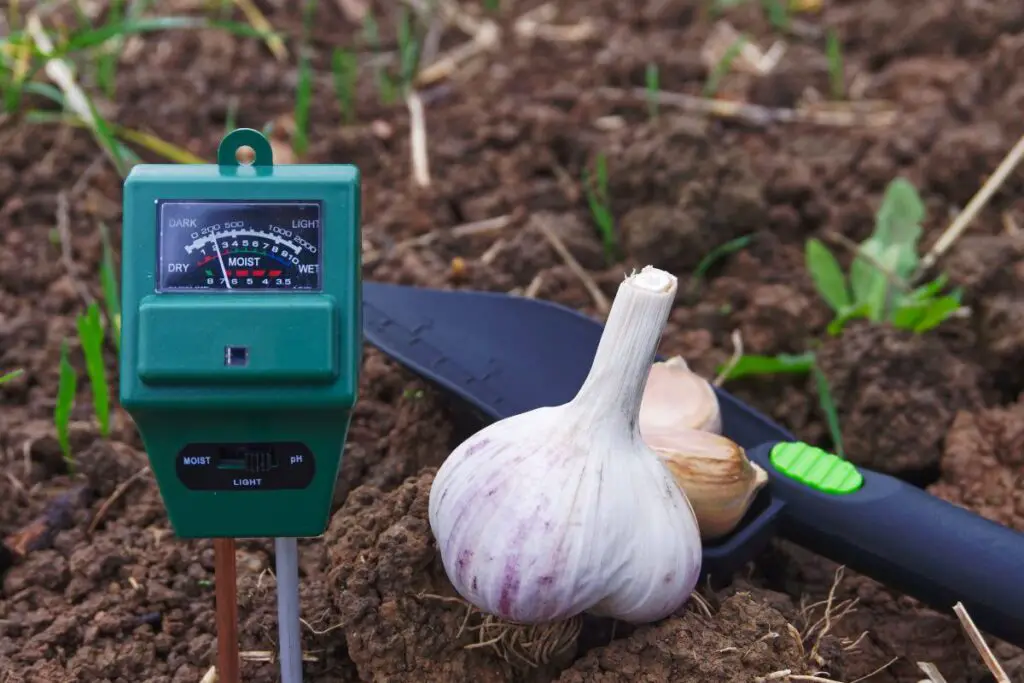
Garlic plants are excellent cold-tolerant plants.
They can endure temperatures as low as -20 to -30°F and as high as 80°F.
At different stages, garlic requires different temperature ranges:
- For the first two months after planting, garlic cloves require 32-50°F.
- Garlic plants need warm weather to grow. Garlic develops best when the air temperature is around 70°F and the soil temperature is 60°F.
- In the winters, the best temperature is between 30-50°F.
Though garlic can tolerate various temperature ranges, especially cold, it will still get hurt if it receives frost.
It is important to cover the cloves in winter.
Otherwise, the garlic heads can die when temperatures drop to 5-12°F.
Sometimes, the soil around the garlic cloves can displace, and the roots can tear up due to frost.
Garlic also reacts negatively during high temperatures.
Though garlic needs the sun’s warmth for adequate plant growth and bulb development, temperatures above 90°F will stunt the growth.
You can plant garlic depending on the season of your region and varieties if your region receives too much hot or cold weather.
If your area gets extreme cold, grow Hardneck varieties.
They are extremely cold-hardy and can endure excessive frosty weather.
If you are from hotter regions, grow Softneck varieties.
They can tolerate more heat than the Hardnecks.
Besides, Softneck requires less vernalizing than Hardnecks.
Don’t forget to mulch the soil bed during winters.
Water the plant well if the weather is hot and the sunlight is harsh.
The more light it gets, the more water it will absorb.
Also read: Garlic Plant Temperature Tolerance: Ideal Temperature+Extreme
8. Remove the scapes from the plant.
Scapes are flower heads of the garlic plants.
There are two types of garlic – Hardneck and Softneck.
Hardneck varieties produce scapes that you must harvest before harvesting the garlic bulbs.
Otherwise, these scapes will take up all the moisture and nutrients, making the bulbs smaller.
You should observe the plant’s growth to harvest scapes at the right time.
Remove the scapes from the plants when they turn in two spiral rounds.
It will let the bulbs have enough nutrients from the plant, making them tastier and bigger.
You can use these scapes in your dishes.
They have a sweet flavor and smell of garlic.
9. Harvest Garlic at the right time.
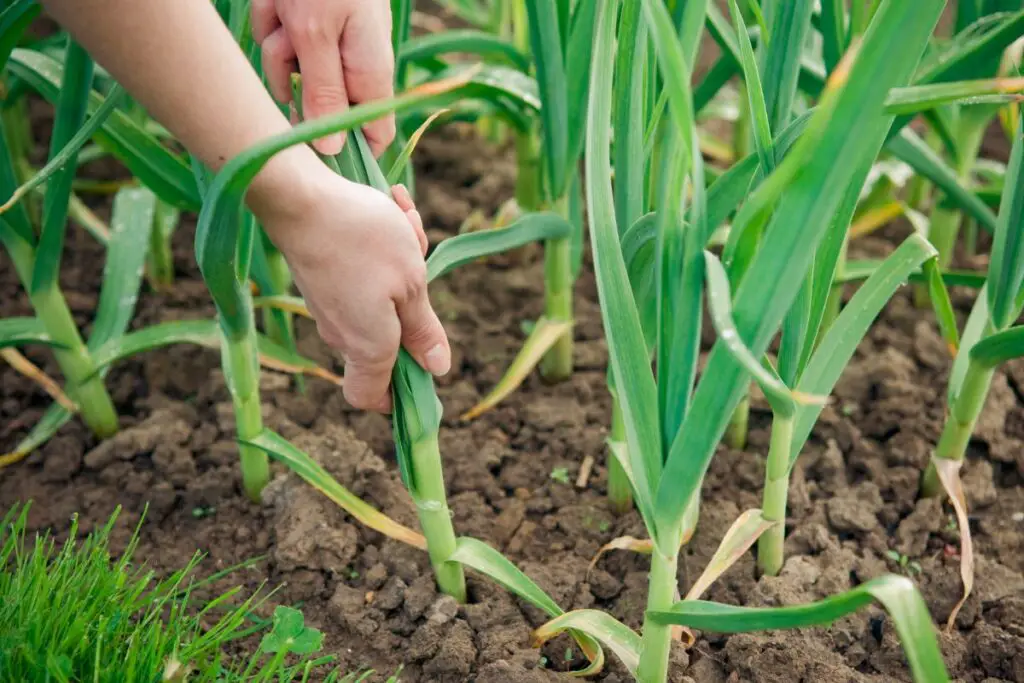
Harvesting at the right time is very vital.
Early or late harvesting can create issues.
To determine the best time for harvest, you should observe the plant’s growth conditions.
Garlic is ready for harvest when the lower leaves turn yellow, and the upper leaves are still green.
It means your garlic is ready to harvest when the plant has just started to die, and 40% of the leaves have turned yellow.
Harvest before the whole plant dies.
If you wait for the whole plant to die, the bulbs will either rot under the ground or split open.
Once the bulbs split open and the cloves come out of their outer skin, they will be susceptible to fungal infections.
You cannot store these split-up bulbs.
So, use them fresh right after harvesting for cooking purposes.
If you harvest the plant early, you will not get the desired bulb size.
The cloves will have excessive moisture, and the bulbs will take time to dry.
The bulbs grow best in the final months of harvest.
Taking them out interferes with their development and makes them small.
Your time and energy for so many months get wasted.
Also read: When Is Garlic Ready To Harvest? (+How To)
10. Proper cure and storage are very important, especially if you want to replant them in the next season.
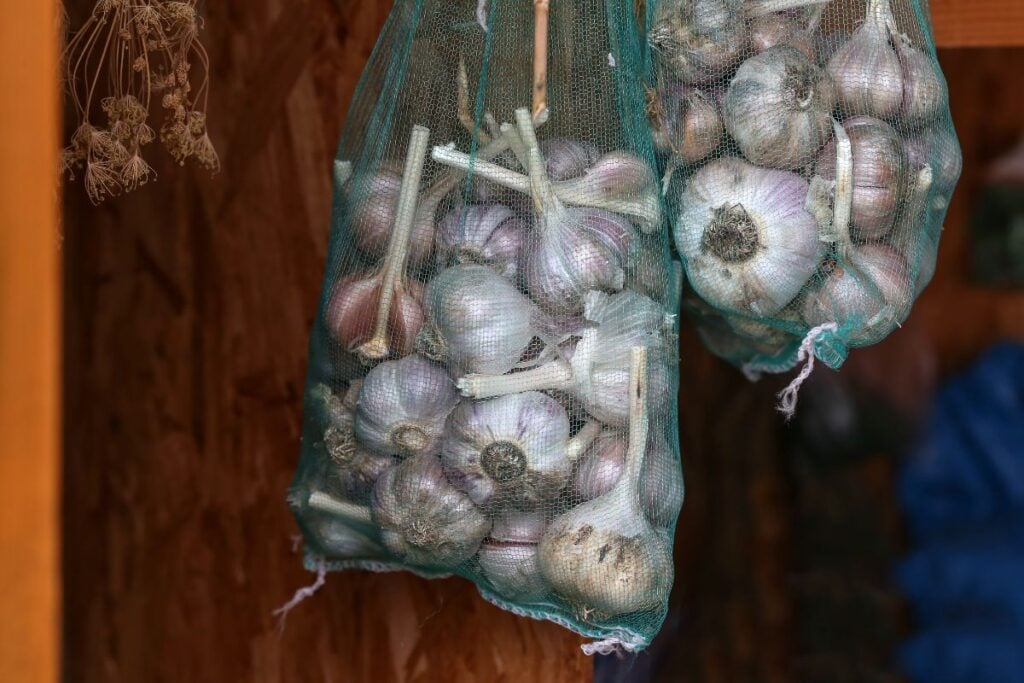
Once you are done harvesting the bulbs, it is time to store them.
You cannot use them immediately unless you wish to cook them.
For curing, let the bulbs dry out for some weeks.
Don’t remove the leaves immediately as the bulbs will absorb the green leaves’ nutrients.
Once the bulbs have dried for 2-3 weeks, clean the bulbs.
All the green leaves will turn brown by now.
So, it is time to remove them.
Trim the leaves at half inches.
Don’t cut off all the leaves; only go for the dirtiest ones.
Now, time for storage.
Store the garlic in a dark, dry, and cool place where the temperature is around 30-50°F and humidity is average, around 50%. For long-term storage, keep 30-32°F temperature.
You can use some of the bulbs from storage and store the rest for replanting in the next year.
Also read: How To Save Garlic For Planting? (Storing Garlic)
11. Propagate garlic to grow garlic and get more garlic.
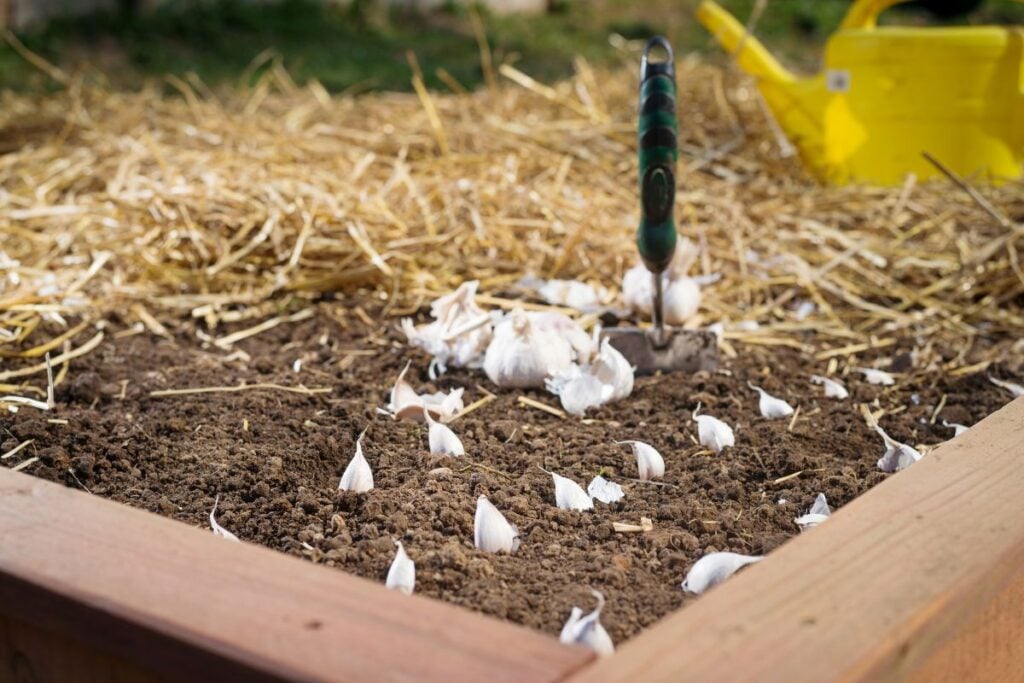
Propagation is the only way to grow garlic and get more garlic.
If you don’t have an existing bulb, you must buy and propagate them to grow them.
The first method involves separating the cloves from the existing bulbs and planting them in the ground.
It has been going on for years.
The second method is from the bulbils.
I have already mentioned earlier that the Hardneck varieties produce long stalks called scapes.
If you wish to grow garlic from bulbils, let the scape remain.
Not harvesting the scapes will divert the plant’s focus from bulb development to scape development.
The outer skin of the bulbil pod will have several small bulbs once it cracks.
Cut off the scape head and hang it for drying in the same way as you cure the bulbs.
Let them dry for 6 months.
When you rub the pod, the bulbs drop off the pod and get ready for planting.
While planting, make sure the bulbil has a wrapper.
Plant them 6 inches apart and also 6 inches apart in rows.
Cover them with soil and water the bulbs well.
Give them only 0.5-1 inch of water per week.
Within 240 days, the bulbil will become a mature plant.
In another 240 days, harvest the bulbs.
The third method is from seed.
Remove the bulbil with tweezers and let the real flower grow and pollinate.
After 45-60 days of pollination, the seeds get ready for harvest.
Place the seeds into a refrigerator after harvest for 4 weeks.
Then soak them and sow them in ordinary soil or sterile seed potting mix.
If the seeds are in good health, they should germinate within 6-8 days.
If they don’t germinate, don’t get upset.
You should know that seed propagation has lower rates of success.
Also read: Problems With Garlic Plants (Yellow, Brown, Drooping, Bugs, & More)
Final words
Garlic is easy to grow if you know the right care tips.
The right time to plant garlic is in the fall. Soak garlic before planting in warm water, vinegar, alcohol, or fertilizers to prevent disease and stimulate growth.
Give them good sunlight and plant them in well-drained fertile soil. Water and feed them well in the growing season and avoid them during winters.
Don’t forget to mulch the soil bed after planting and during winter. Harvest the bulbs at the right time. Cure, clean, and store the bulbs properly.
Propagate garlic from cloves, seeds, and bulbils to get more bulbs.
Reference: The Pennsylvania State University, Garlic Production for the Gardener, University of Massachusetts Amherst, Ohio State University Extension.
